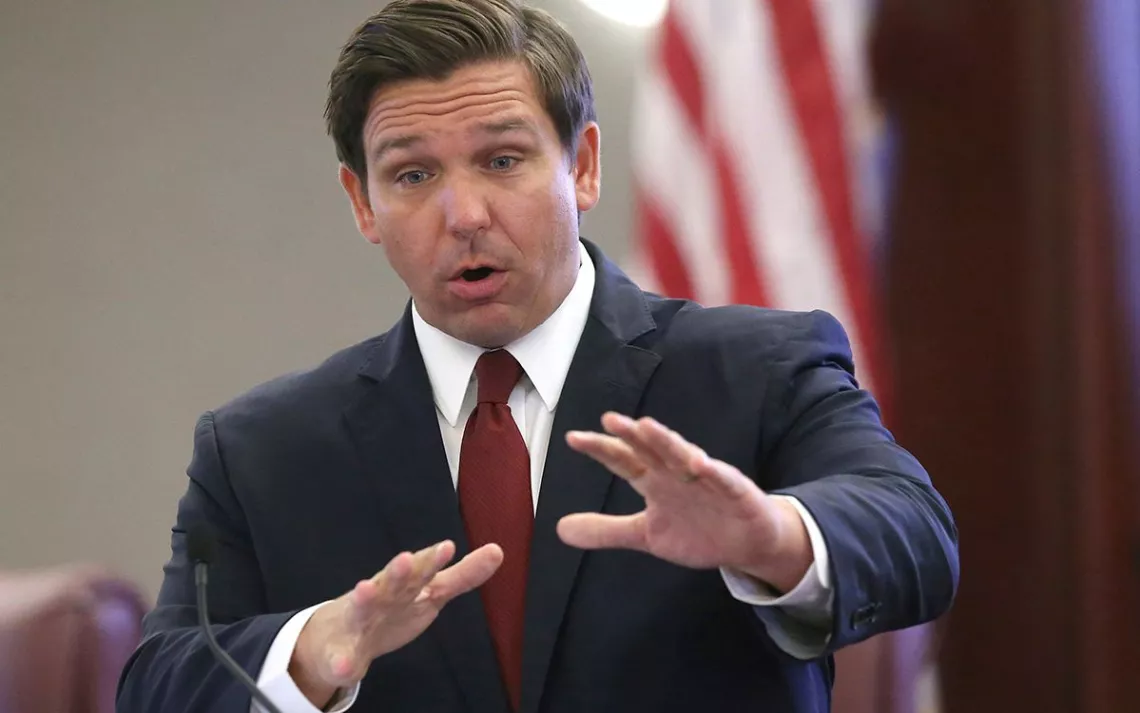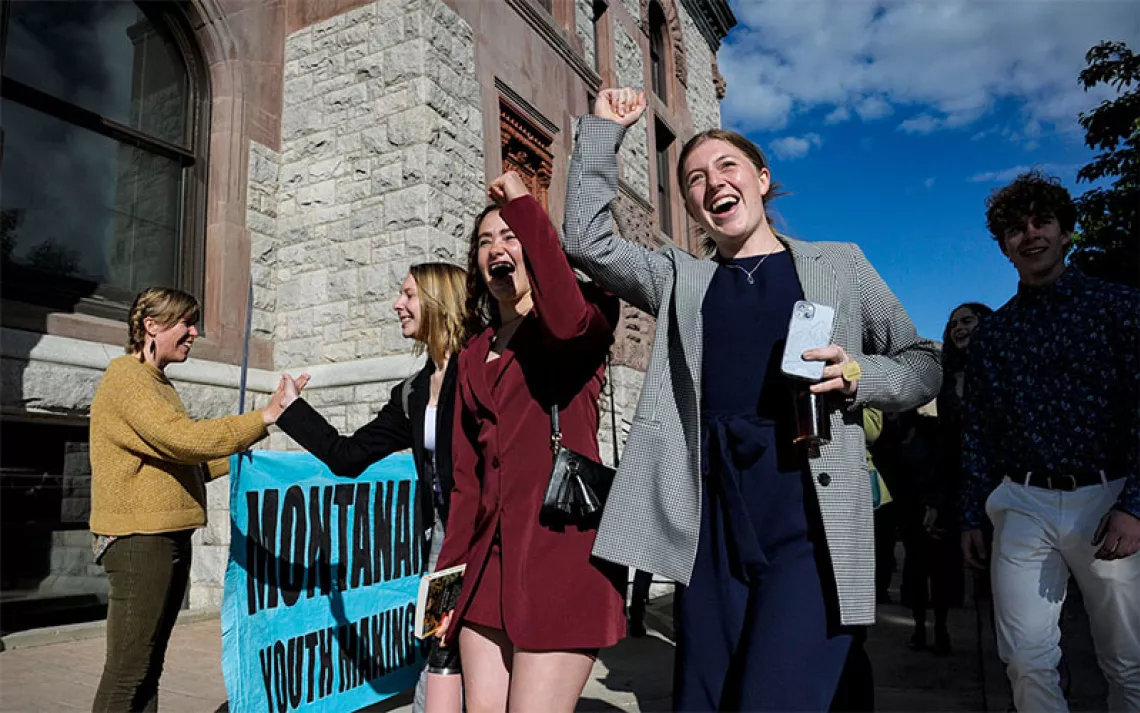Can DeSantis Tackle Climate Change Without Admitting It’s Real?
His Resilient Florida initiative addresses the impacts of the climate crisis but not the causes

Photo by Steve Cannon/AP
When Ron DeSantis was running for governor in 2018, he found himself in a quandary. On the one hand, the effects of climate change in Florida—increased flooding in coastal communities, more-active hurricane seasons, and the loss of wildlife habitat—had become impossible to ignore. In the nation’s third-most-populous state, a 2018 poll found that 66 percent of voters considered climate change “a serious problem.”
But the Republican Party was deep in the grip of climate denialism (as has been the case for decades). DeSantis’s predecessor, Governor Rick Scott, had forbidden state employees from even using the term "climate change" and ordered them to refer to sea level rise as “nuisance flooding,” an absurdity that did not escape the attention of the nation’s comedians.
So the Donald Trump–endorsed Republican nominee sought to walk a narrow tightrope.
While he was no “climate change denier,” he said, he did not want to be mistaken for a “climate change believer.” He was not, he argued emphatically, “in the pews of the global warming left.”
Once elected, DeSantis seemed to live up to the expectation that when it came to the environment, he would at least do better than his predecessor. Just days after moving into the governor’s mansion in January 2019, he signed an executive order that called for dedicating billions of dollars to Everglades restoration and protection, improving water quality, creating the Office of Resilience and Coastal Protection, and appointing the state’s first chief science and chief resilience officers. Major Florida newspapers were soon heralding DeSantis as “Florida’s green governor” and “bold on climate change.”
That mist of good fortune began to dissipate on May 17, 2019, when the governor signed legislation approving the construction of three toll roads that would cut through sensitive wildlife areas, much of them home to the endangered Florida panther. For environmentalists, more disappointments were on the way. The following February, when his choice for the state’s first chief resilience officer, Dr. Julia Nesheiwat, was called away to serve as President Trump’s fourth homeland security adviser, DeSantis failed to appoint a new one. The position remains vacant today.
Nowhere is the governor's two-steps-forward-one-step-back approach to environmental stewardship, and particularly climate change, more evident than in his $96.6 billion budget proposal for the 2021–22 fiscal year. Released on January 28, the proposal includes a $1 billion program called Resilient Florida that DeSantis says would “address the challenges of sea level rise, intensified storm events, and localized flooding.” The budget, which requires approval by the Florida legislature, also includes $50 million for beach renourishment and $10 million for a Resilient Coastlines Program that would in part try to protect the state’s coral reefs.
Noticeably lacking from the budget, as well as from the website created to promote it, are plans to address the causes of climate change or to reduce Florida’s carbon emissions.
“I think the irony of the proposal was that he listed all the impacts of climate change but never actually said ‘climate change,’” state representative Anna V. Eskamani (D-Orlando) says. “And so we’re going to continue to spend money on resiliency over the years where we could also be making investments in taking the state off fossil fuels and actually tackling the climate change crisis in front of us.”
To put it another way, she says, “we just keep Band-Aiding things, but we’re not actually stopping the bleeding.”
Eskamani and state senator Lori Berman (D-Boynton Beach) are sponsoring legislation that would require Florida to operate on 100 percent renewable energy by 2040 and to be carbon-neutral by 2050.
Berman, who sits on the Florida Senate’s Appropriations Subcommittee on Agriculture, Environment, and General Government, says she is “pretty optimistic” the governor’s Resilient Florida program will receive a warm reception when the Republican-controlled legislature opens its 60-day regular session on March 2. “I’m happy to see that we’re doing some resiliency, so I support the governor’s proposal,” she says. “I’d also like to see it supplemented with discussions about the causes of climate change, so that we don’t have to do reactive work and we can be more proactive.”
According to the latest estimates by the US Energy Information Administration, Florida ranks fourth in energy consumption in the country and second in the production of electricity, 75 percent of which is powered by natural gas. In the Sunshine State, solar power and other forms of renewable energy accounted for only 4 percent of net electricity generation in 2019, the year for which the most recent data is available.
The lack of investment in solar can be attributed to the outsize influence the state’s utility companies wield in the Republican-controlled Florida legislature. In 2020, utility companies donated more than $4 million to the state’s legislative candidates. While the industry is gradually expanding into solar energy, the majority of the power it provides to Floridians is generated by natural gas, a fossil fuel. Meanwhile, Republican state legislators are sponsoring at least four bills that would prevent Florida municipalities from setting clean-energy goals. Homeowners interested in installing solar have been stymied by the state, where only utility companies are allowed to sell solar energy to consumers.
“Even among my Democratic colleagues, the influence of fossil fuel companies is very real,” Eskamani says. “So, getting movement on these issues is a challenge when the biggest political donors are against you.”
Neither Eskamani nor Berman is optimistic about their bills’ chances.
As becomes clearer with every king tide flooding the streets of Miami Beach, the Category 5 hurricanes devastating coastal towns, and each broken heat record, Florida is in dire need of increased climate resiliency, and fast. But all the 20-foot seawalls and elevated homes won’t mean much if DeSantis and his Republican colleagues don’t begin to talk about—and accept—the science that explains why those measures are necessary in the first place.
In the meantime, Deborah Foote, acting chapter director of Sierra Club Florida, is worried that the Resilient Florida program will be viewed as a real effort to combat climate change. “We’ve been very concerned about the framing of Governor DeSantis being an environmentalist,” Foote says. “If you look at what has transpired—while he’s certainly better than Governor Scott, who was probably as low as you can go—I think that people are mistaken to call him that. We’ve had very, very little action on addressing climate change, addressing the source of climate change, and instead [the governor] is using our taxpayer dollars to fix it after it’s happened. And this is a continuation of that same policy.”
Foote says Sierra Club Florida will release its annual report card on the governor’s environmental performance by the opening of the legislative session on March 2. The chapter gave DeSantis a D on his previous report card. “I can’t tell you exactly what [the new grade] is yet,” Foote says.
She can say this much, though: “You saw his grade for 2019? I fully anticipate his grade will be lower than that for 2020.”
 The Magazine of The Sierra Club
The Magazine of The Sierra Club



